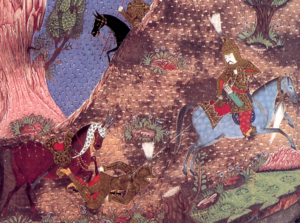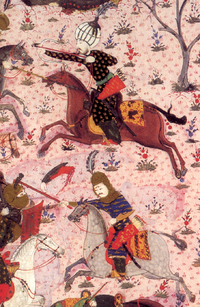
Akinci
Encyclopedia



Light cavalry
Light cavalry refers to lightly armed and lightly armored troops mounted on horses, as opposed to heavy cavalry, where the riders are heavily armored...
,scout divisions (delil) and advance troops of the Ottoman Empire
Ottoman Empire
The Ottoman EmpireIt was usually referred to as the "Ottoman Empire", the "Turkish Empire", the "Ottoman Caliphate" or more commonly "Turkey" by its contemporaries...
's military
Military of the Ottoman Empire
The history of military of the Ottoman Empire can be divided in five main periods. The foundation era covers the years between 1300 and 1453 , the classical period covers the years between 1451 and 1606 , the reformation period covers the years between 1606 and 1826 ,...
. When the pre-existing Turkish ghazis were incorporated into the Ottoman Empire's military they became known as "akıncı." They were one of the first divisions
Division (military)
A division is a large military unit or formation usually consisting of between 10,000 and 20,000 soldiers. In most armies, a division is composed of several regiments or brigades, and in turn several divisions typically make up a corps...
to face the opposing military and were known for their prowess in battle. Unpaid, they lived and operated as raiders on the frontiers of the Ottoman Empire, subsisting totally on plunder.
In battle their main role was to act as advance troops on the front lines and demoralise the marching opposing army by using guerilla tactics, and to put them in a state of confusion and shock. They could be likened to a scythe in a wheat field. They would basically hit the enemy with arrows
Turkish archery
- Origins :Traditional Turkish archery’s origins go back to the first millennium B.C. to Scythian, Hun and other early Asian archery tradition. The horseback archers of Central Asian steppes have used very similar archery tackle and fighting strategies throughout entire history and the nomadic life...
. When attacked in melee
Mêlée
Melee , generally refers to disorganized close combat involving a group of fighters. A melee ensues when groups become locked together in combat with no regard to group tactics or fighting as an organized unit; each participant fights as an individual....
, they would retreat while still shooting backwards. They could easily outrun heavy cavalry
Heavy cavalry
Heavy cavalry is a class of cavalry whose primary role was to engage in direct combat with enemy forces . Although their equipment differed greatly depending on the region and historical period, they were generally mounted on large powerful horses, and were often equipped with some form of scale,...
because they were lightly armed and their horses were bred for speed as opposed to strength. Akıncı forces carried swords, lances, shields and battle axes as well, so that in a field of combat, they could face the enemy first and fight melee. In some Ottoman campaigns, such as the Battle of Krbava field
Battle of Krbava field
The Battle of Krbava field , was fought between the Ottoman Empire of Bayezid II and a Croatian army of the Kingdom of Croatia in personal union with the Kingdom of Hungary on September 9, 1493 in the Krbava field, a part of Lika region, southern Croatia...
, Akıncı forces were the only units utilized without any need for Ottoman heavy cavalry or infantry.
Because of their mobility akıncı were also used for reconnaissance
Reconnaissance
Reconnaissance is the military term for exploring beyond the area occupied by friendly forces to gain information about enemy forces or features of the environment....
and as a vanguard force to terrorize the local population before the advance of the main Ottoman forces. Since they were irregular militia, they were not bound by peace treaties, so they could raid border villages and attack enemy garrisons, fortresses and border posts during peace time, constantly harassing the enemy and checking the weak spots on the rival country's defences. They would also attack trading routes to cut enemy's supply and transportation.
Akıncı forces were led by certain families. Well-known akıncı families were Malkoçoğlu, Turhanlı, Ömerli
Ömerli
Ömerli may refer to:*Ömerli, Mardin, in Turkey*Ömerli, Şanlıurfa, in Turkey*Galini, Cyprus, also known as Ömerli, in Northern Cyprus...
, Evrenosoğlu, and Mihalli. These akıncı clans were mainly composed of Turkmen
Turkmen people
The Turkmen are a Turkic people located primarily in the Central Asian states of Turkmenistan, Afghanistan, and northeastern Iran. They speak the Turkmen language, which is classified as a part of the Western Oghuz branch of the Turkic languages family together with Turkish, Azerbaijani, Qashqai,...
tribal warriors with a leading dynasty which descended from the warrior ghazi
Ghazi
Ghazi is a title given to Muslim warriors or champions. It may be used out of respect or officially. Many of the Ottoman Sultans and Caliphs wore this title officially , along with Khan and Caesar...
s of the first Ottoman ruler Osman I
Osman I
Osman I or Othman I or El-Gazi Sultan Osman Ghazi, or Osman Bey or I. Osman, Osman Gazi Han), nicknamed "Kara" for his courage, was the leader of the Ottoman Turks, and the founder of the dynasty that established and ruled the Ottoman Empire...
. Adventurers, soldiers of fortune, mercenaries, warrior dervishes, and civilians looking for fortune and adventure would also join the ranks of akıncı gangs.
Since akıncıs were seen as irregular militia, they did not have regular salaries as kapikulu
Janissary
The Janissaries were infantry units that formed the Ottoman sultan's household troops and bodyguards...
soldiers, or fiefs like timarli soldiers. Their only income was the plunder and the booties they got from the raids.
Akıncıs used to wear colourful and interesting clothes to shock and confuse their opponents. They used to wear eagle wings on their backs(this tradition was imitated by hungarian hussar troops later), put on helmets with bull horns, wear coats made of leopard skin. Because of their unusual appearance and their almost suicidally courageous battle tactics, akıncıs were nicknamed by the public as "deliler" (the crazies), and "serdengeçtiler" (headgivers: meaning "the one who has already given his head to enemy", a man who does not care if he lived or died).
Akıncı system had an important role at the establishment of the empire and fast expansion of Ottoman territories in Europe. Though the akıncı system worked excellently from the 14th to 16th centuries, it begun to decline after the 16th century. Starting with 16th-17th century nomadic Tatar
Tatars
Tatars are a Turkic speaking ethnic group , numbering roughly 7 million.The majority of Tatars live in the Russian Federation, with a population of around 5.5 million, about 2 million of which in the republic of Tatarstan.Significant minority populations are found in Uzbekistan, Kazakhstan,...
Nogay cavalry from Kırım Khanate
Crimean Khanate
Crimean Khanate, or Khanate of Crimea , was a state ruled by Crimean Tatars from 1441 to 1783. Its native name was . Its khans were the patrilineal descendants of Toqa Temür, the thirteenth son of Jochi and grandson of Genghis Khan...
also served as akıncıs for the Ottoman Empire. After the Ottoman advance in Europe stopped, akıncı warriors became unnecessary and without the economy of plunder this warrior class slowly faded away. After the modernization of the Ottoman army, the last few officially recognized akıncı clans were abolished. Still, last remnants of akıncı system existed till late 19th century in the Balkan provinces as the bashibozouk (irregular) warriors.
In Literature
Akıncı lifestyle with battles and plunder was a romantic fantasy for the public and so akıncıs were a popular subject in Ottoman folk literature and music. "Serhad türküleri" or "border folk songs" is a subcategory of Ottoman folk music dealing mostly with akıncı raids and battles or love affairs of akıncı warriors, sometimes odes to fallen warriors. Alişimin Kaşları Kara" (My Aliş had Black Eyebrows), "Estergon Kalası" (Castle of Estergon) are some of the most popular examples. In the modern period, romantic-revivalist Turkish writers also wrote poems about akıncıs. Yahya KemalYahya Kemal Beyatli
Yahya Kemal Beyatlı , born Ahmed Agâh, was a leading Turkish poet and author, as well as a politician.-Biography:...
's "Akıncılar" is one of the most well-known example on this subject:
"A thousand horsemen raiding, we were joyful like children;
A thousand horsemen, we beat a huge army that day!
White helmeted commander screamed: ahead!
We crossed Danube in procession on a summer day...
We striked like lightning from seven directions,
Like a lightning, following Turkish riders.
One day full galloping on our horses,
We lifted up from earth seven layers to sky...
We see red roses of heaven blooming today,
That crimson vision still trembles in our minds!
A thousand horsemen raiding, we were joyful like children;
A thousand horsemen, we beat a huge army that day!
Yahya Kemal Beyatlı
Yahya Kemal Beyatli
Yahya Kemal Beyatlı , born Ahmed Agâh, was a leading Turkish poet and author, as well as a politician.-Biography:...

